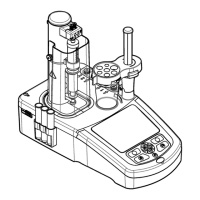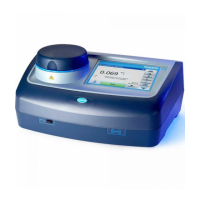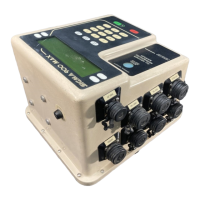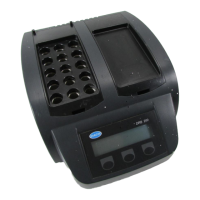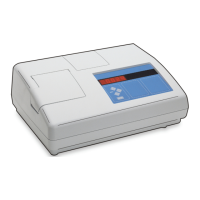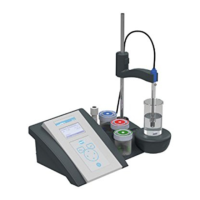Amperometric Titration Theory
Amperometric Titration Theory
50081_Titration.fm Page 149
titration procedure buffered at pH 4 is recommended for the amperometric titration of
total chlorine in treated wastewaters, and agricultural and industrial discharges.
1.2.5 Choice of Reductant
In the forward amperometric titration method, use only phenylarsine oxide (PAO) as the
titrant when measuring total chlorine. PAO gives a sharper end point than standard
thiosulfate at pH 4. This is shown comparatively in
Figure 3 on page 150. The titration plots compare the titration curves obtained for 82
µg/L monochloramine standard using a continuous addition of standard thiosulfate and
standard PAO titrants. The rate at which triiodide is generated with thiosulfate evidently
changes as the end point is approached. This leads to uncertainty when determining
the end point graphically, see (a) in Figure 3 on page 150. The use of PAO gives a
relatively sharper end point, see (b) in Figure 3 on page 150.
In the case of the amperometric back titration method, the addition of excess PAO or
thiosulfate is acceptable. The titration end points for both reductants are equivalent when
standard iodine is the titrant.
1.3 Errors Common to Total Chlorine Determinations
Most of the common total chlorine methods are based on the oxidation of iodide to
triiodide (I
3
–
) ion. Several sources of errors related to the iodide/triiodide reaction are
discussed here:
• oxidation of the iodide (I
–
) reagent
• volatilization of elemental iodine
• iodine or iodate (IO
3
–
) contamination in the iodide reagent
• consumption of triiodide by sample components
Potassium iodide reagent may be oxidized by the following reaction:
4I
–
+ O
2
+ 4H
+
→ 2I
2
+ 2H
2
O
The reaction is accelerated by low pH, light, and trace metal ions. Iodide reagent
solutions are quite susceptible to oxidation from exposure to light and oxygen.
Work conducted at the Electric Power Research Institute (EPRI)
*
indicates that oxidants
equivalent to 1 mg/L chlorine can be generated in one day in a 0.1 M KI stock solution.
Potassium iodide purity is critical in trace total chlorine determinations. The iodide
should be free of iodine or iodate which can react directly with chlorine or chloramines
in the sample. Even solid potassium iodide can be oxidized with enough exposure to
oxygen and ultraviolet light. Hach controls its KI reagent for iodine and trace oxidant
contamination before packaging.
Volatilization of free iodine from the reaction of oxidant with iodide is decreased
somewhat because excess iodide is present in the sample. Excess iodide causes formation
of the less volatile triiodide species. EPRI
†
reported the error due to iodine volatilization
is probably a small percent. Quick analysis will also minimize iodine loss by
volatilization.
Adsorption of the produced iodine on suspended particles can be a serious problem in the
case of muddy or highly organic-rich waters. A good example is the blue complex
formed between I
2
and starch, which is the visual indicator for the starch iodine test. In
*. EPRI Report EA-929, Project 879-1, October 1978.
†. EPRI Report EA-929, Project 879-1, October 1978.

